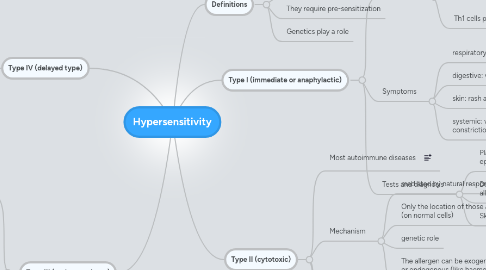
1. Type IV (delayed type)
1.1. dendritic cells activate Th1 cells which release INF gamma and TNF
1.2. these cytokines activates macrophages to form granuloma and causes tissue distraction and necrosis
1.3. examples
1.3.1. Multiple sclerosis
1.3.2. Tuberculosis
1.3.3. Insuline dependant DM
1.3.4. contact dermatitis
2. Type III (toxic complexes)
2.1. angry neutrophils disease
2.2. Mechanism
2.2.1. large amount of antigen/antibody complexes form and precipitate on tissues (bone and blood vessels
2.2.2. Neutrophils and macrophages cannot phagocyte the complexes so they get hyper-activated "angry" and cause inflammation
2.2.3. Tissue damage occur
2.2.4. Can be localized (joint) or systemic (serum sickness)
2.3. diagnosis
2.3.1. demonstration of immune complexes in tissue biopsy
3. Type II (cytotoxic)
3.1. Most autoimmune diseases
3.2. Mechanism
3.2.1. mediated by natural response of IgG and IgM
3.2.2. Only the location of those antigens is wrong (on normal cells)
3.2.3. genetic role
3.2.4. The allergen can be exogenous (like penicillin) or endogenous (like haemolytic disease of the new born)
3.3. Symptoms
3.3.1. depend on the target cells (RBC leads to haemolytic anaemia)
3.4. Diagnosis
3.4.1. clinical diagnosis
3.4.2. demonstration of systemic IgG and IgM antibodies to the specific allergen
4. Type I (immediate or anaphylactic)
4.1. Mechanism
4.1.1. Genetics
4.1.1.1. genetic predisposition to type I allergy is termed "atopy"
4.1.1.2. associated with genetic morphisms in
4.1.1.2.1. IL-4, IL-4R, high affinity IgE receptor, and MHC-II
4.1.2. Th1 cells produces IL-13 and 4
4.1.2.1. makes the plasma cells produce IgE antibody (instead of IgM and IgG, class switching)
4.1.2.1.1. binds to mast cells
4.2. Symptoms
4.2.1. respiratory: sneezing, rhinitis, and asthma
4.2.2. digestive: vomiting
4.2.3. skin: rash and itching
4.2.4. systemic: vasodilatation, bronchiole constriction, and shock
4.3. Tests and diagnosis
4.3.1. Plasma level of IgE and eosinophils during the episode
4.3.2. Detection of specific antibodies to specific allergens
4.3.3. Skin test
